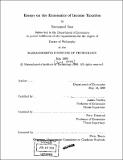Essays on the economics of income taxation
Author(s)
Saez, Emmanuel
DownloadFull printable version (9.238Mb)
Other Contributors
Massachusetts Institute of Technology. Dept. of Economics.
Advisor
James Poterba and Peter Diamond.
Terms of use
Metadata
Show full item recordAbstract
The first chapter derives optimal income tax formulas using the concepts of compensated and uncompensated elasticities of earnings with respect to tax rates. This method of derivation casts new light on the original Mirrlees formulas of optimal taxation and can be easily extended to a heterogeneous population of taxpayers. A simple formula for optimal marginal rates for high income earners is derived as a function of the two elasticities of earnings and the thickness of the income distribution. Optimal income tax simulations are presented using empirical wage income distributions and a range of realistic elasticity parameters. The second chapter derives the non-linear income tax schedule which minimizes dead-weight burden without any regard for redistribution. The features of this problem are shown to be equivalent to the Mirrlees' optimal income tax problem. The tax schedule minimizing dead-weight burden is an optimal income tax schedule in which the government applies particular marginal welfare weights at each income level. In the case of no income effects, these marginal welfare weights are the same for everybody. The last chapter uses a panel of individual tax returns and the 'bracket creep' as source of tax rate variation to construct instrumental variables estimates of the sensitivity of income to changes in tax rates. Compensated elasticities can be estimated by comparing the differences in changes in income between taxpayers close to the top-end of a tax bracket to the other taxpayers. The elasticities found are higher than those derived in labor supply studies but smaller than those found previously with the same kind of tax returns data.
Description
Thesis (Ph.D.)--Massachusetts Institute of Technology, Dept. of Economics, c1999. Includes bibliographical references (p. 161-166).
Date issued
1999Department
Massachusetts Institute of Technology. Department of EconomicsPublisher
Massachusetts Institute of Technology
Keywords
Economics.